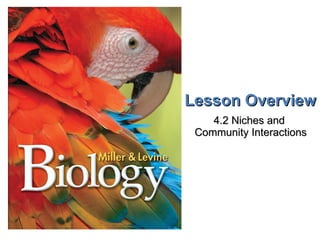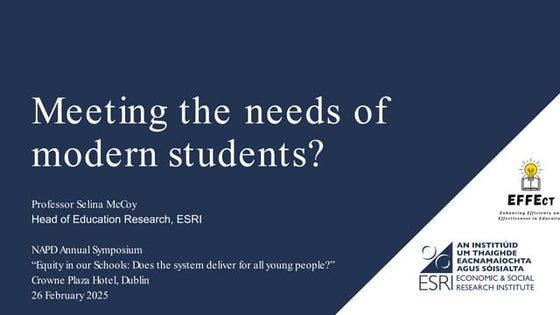4.2 -- BIO
The document discusses different types of species interactions within ecological communities. It defines key terms like niche, which describes how a species interacts with its environment, and resources, which are necessities for life like food and shelter. Competition for resources shapes communities by causing species to divide resources in order to coexist. Predator-prey and herbivore-plant relationships also influence community structure. Some species, called keystone species, can have large impacts on a community despite small population sizes through complex interaction chains, like sea otters regulating sea urchin populations and protecting kelp forests. Symbiotic relationships between species include mutualism, parasitism, and commensalism.



















Recommended


























































More Related Content
What's hot (20)








































Similar to 4.2 -- BIO (20)






































Recently uploaded (20)
































4.2 -- BIO
- 1. Lesson Overview 4.2 Niches and Community Interactions
- 2. Tolerance Tolerance ï the ability to survive and reproduce under a range of environmental circumstances. Every species has its own range of tolerance. When an environmental condition (ex. Temperature) extends beyond or below organismâs optimum range (tolerance), the organism experiences stress. The organism must then expend more energy to maintain homeostasis, and so has less energy left for growth and reproduction.
- 3. Tolerance A speciesâ tolerance for environmental conditions, helps determine its habitat Habitat ï place where an organism lives.
- 4. Defining the Niche Niche ï d escribes an organismâs environment (where it lives, and how it interacts with biotic and abiotic factors in the environment.
- 5. Ėý
- 6. Resources and the Niche Resource ï refers to any necessity of life, such as water, nutrients, light, food, or space. For plants, resources can include sunlight, water, and soil nutrients. For animals, resources can include nesting space, shelter, types of food, and places to feed.
- 7. Physical & Biological Aspects of the Niche Physical aspects ï abiotic factors ex. Water, temperature, etc Biological aspects ï biotic factors ex. All living factors that affect the organism ex. Producers & consumers.
- 8. Competition How does competition shape communities? By causing species to divide resources, By helping to determine the number and kinds of species in a community and By determining the niche each species occupies. Ex. plant roots compete for resources such as water and nutrients in the soil. Animals compete for resources such as food, mates, and places to live and raise their young. Competition can occur both between members of the same species (known as intraspecific competition) and between members of different species (known as interspecific competition).
- 9. The Competitive Exclusion Principle The competitive exclusion principle states that no two species can occupy exactly the same niche in exactly the same habitat at exactly the same time. Ex. If two species attempt to occupy the same niche, one species will be better at competing for limited resources and will eventually exclude the other species.
- 10. Dividing Resources Instead of competing for similar resources, species usually divide them. ex. the three species of North American warblers shown all live in the same trees and feed on insects. But one species feeds on high branches; another feeds on low branches, and another feeds in the middle.
- 11. Predator-Prey Relationships An interaction in which one animal (the predator) captures and feeds on another animal (the prey) is called predation. Predators can affect the size of prey populations in a community and determine the places prey can live and feed. Birds of prey, for example, can play an important role in regulating the population sizes of mice, voles, and other small mammals.
- 12. Herbivore-Plant Relationships An interaction in which one animal (the herbivore) feeds on producers (such as plants) is called herbivory. Herbivores, like a ring-tailed lemur, can affect both the size and distribution of plant in a community and determine the places that certain plants can survive and grow. Ex. dense populations of white-tailed deer are eliminating their favorite food plants from many places across the United States.
- 13. Keystone Species Sometimes changes in the population of a single species, often called a keystone species, can cause dramatic changes in the structure of a community. Ex. Sea otters devour large quantities of sea urchins. Sea Urchins are herbivores whose favorite food is kelp, giant algae that grow in undersea âforests.â Sea Otters Sea Urchins
- 14. Keystone Species A century ago, sea otters were nearly eliminated by hunting. Unexpectedly, the kelp forest nearly vanished. Without otters as predators, the sea urchin population skyrocketed, and armies of urchins devoured kelp down to bare rock. Without kelp to provide habitat, many other animals, including seabirds, disappeared. Otters were a keystone species in this community.
- 15. Keystone Species After otters were protected as an endangered species, their population began to recover. As otters returned, the urchin populations dropped, and kelp forests began to thrive again. Recently, however, the otter population has been falling again, and no one knows why.
- 16. Symbioses Any relationship in which two species live closely together is called symbiosis , which means âliving together.â The three main classes of symbiotic relationships in nature are mutualism, parasitism, and commensalism.
- 17. Mutualism Relationship between species in which both benefit is known as mutualism. Ex. The sting of the sea anemone captures prey and protects it from predators. The clownfish is immune to anemone stings. When threatened by a predator, clownfish seek shelter by snuggling deep into an anemoneâs tentacles. If an anemone-eating species tries to attack the anemone, the clownfish chases away the predators.
- 18. Parasitism Parasitism, relationships in which one organism lives inside or on another organism and harms it Ex. Tapeworms live in the intestines of mammals, where they absorb large amounts of their hostsâ food. Fleas, ticks, lice, and the leech shown, live on the bodies of mammals and feed on their blood and skin. Generally, parasites weaken but do not kill their host, which is usually larger than the parasite. Tapeworm in Intestine
- 19. Commensalism commensalism, a relationship in which one organism benefits and the other is neither helped nor harmed. Ex. Barnacles attach themselves to a whaleâs skin. They perform no known service to the whale, nor do they harm it. The barnacles benefit from the constant movement of waterâthat is full of food particlesâpast the swimming whale.





